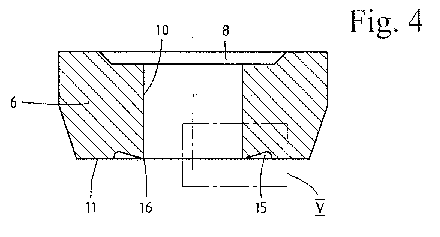Some of the information on this Web page has been provided by external sources. The Government of Canada is not responsible for the accuracy, reliability or currency of the information supplied by external sources. Users wishing to rely upon this information should consult directly with the source of the information. Content provided by external sources is not subject to official languages, privacy and accessibility requirements.
Any discrepancies in the text and image of the Claims and Abstract are due to differing posting times. Text of the Claims and Abstract are posted:
| (12) Patent Application: | (11) CA 2958295 |
|---|---|
| (54) English Title: | TAP ON A METALLURGICAL VESSEL, IN PARTICULAR ON AN ELECTRIC ARC FURNACE |
| (54) French Title: | GOULOTTE DE COULEE SUR UN CONTENANT METALLURGIQUE, EN PARTICULIER UN FOUR A ARC ELECTRIQUE |
| Status: | Deemed Abandoned and Beyond the Period of Reinstatement - Pending Response to Notice of Disregarded Communication |
| (51) International Patent Classification (IPC): |
|
|---|---|
| (72) Inventors : |
|
| (73) Owners : |
|
| (71) Applicants : |
|
| (74) Agent: | MACRAE & CO. |
| (74) Associate agent: | |
| (45) Issued: | |
| (86) PCT Filing Date: | 2015-08-25 |
| (87) Open to Public Inspection: | 2016-03-24 |
| Availability of licence: | N/A |
| Dedicated to the Public: | N/A |
| (25) Language of filing: | English |
| Patent Cooperation Treaty (PCT): | Yes |
|---|---|
| (86) PCT Filing Number: | PCT/EP2015/069409 |
| (87) International Publication Number: | EP2015069409 |
| (85) National Entry: | 2017-02-15 |
| (30) Application Priority Data: | ||||||
|---|---|---|---|---|---|---|
|
The invention relates to a tap on a metallurgical vessel, in particular on an electric arc furnace, comprising a fireproof end brick (6) having an outlet opening (10). On the lower end face (11) of the end brick (6), a groove (15) is provided, which is shaped in such a way that, during the draining of the vessel, a separation edge (16) is formed at the outlet opening (10) by means of the groove. Said groove (15) is annular and has an inclined surface (18) tilted radially outward. Thus, said separation edge (16) is formed directly adjacent to the outlet opening (10). Thus, the tap can be cleaned by shearing off by means of the front edge of the plate of the closing device without manual effort after each tapping process.
L'invention concerne une goulotte de coulée sur un contenant métallurgique, en particulier un four à arc électrique, pourvue d'une brique d'extrémité (6) ignifuge et présentant un orifice de sortie (10). Sur la face frontale (11) inférieure de la brique d'extrémité (6) est ménagée une rainure (15), qui est formée de telle manière qu'avec cette dernière, lorsque le contenant se vide, une arête de rupture (16) est produite près de l'ouverture de sortie (10). Cette rainure (15) est annulaire et est pourvue d'une surface oblique (18) inclinée radialement vers l'extérieur, cette arête de rupture (16) est ainsi formée directement à la suite de l'ouverture de sortie (10). La goulotte de coulée peut donc être nettoyée après chaque opération de coulée sans déployer d'activité manuelle par détachement, par l'arête avant, de la plaque du dispositif de fermeture.
Note: Claims are shown in the official language in which they were submitted.
Note: Descriptions are shown in the official language in which they were submitted.

2024-08-01:As part of the Next Generation Patents (NGP) transition, the Canadian Patents Database (CPD) now contains a more detailed Event History, which replicates the Event Log of our new back-office solution.
Please note that "Inactive:" events refers to events no longer in use in our new back-office solution.
For a clearer understanding of the status of the application/patent presented on this page, the site Disclaimer , as well as the definitions for Patent , Event History , Maintenance Fee and Payment History should be consulted.
| Description | Date |
|---|---|
| Application Not Reinstated by Deadline | 2019-08-27 |
| Time Limit for Reversal Expired | 2019-08-27 |
| Deemed Abandoned - Failure to Respond to Maintenance Fee Notice | 2018-08-27 |
| Inactive: Cover page published | 2017-08-17 |
| Inactive: First IPC assigned | 2017-03-30 |
| Inactive: IPC assigned | 2017-03-30 |
| Inactive: IPC removed | 2017-03-30 |
| Inactive: Notice - National entry - No RFE | 2017-02-24 |
| Application Received - PCT | 2017-02-20 |
| Inactive: IPC assigned | 2017-02-20 |
| Inactive: IPC assigned | 2017-02-20 |
| Inactive: IPC assigned | 2017-02-20 |
| National Entry Requirements Determined Compliant | 2017-02-15 |
| Application Published (Open to Public Inspection) | 2016-03-24 |
| Abandonment Date | Reason | Reinstatement Date |
|---|---|---|
| 2018-08-27 |
The last payment was received on 2017-07-26
Note : If the full payment has not been received on or before the date indicated, a further fee may be required which may be one of the following
Patent fees are adjusted on the 1st of January every year. The amounts above are the current amounts if received by December 31 of the current year.
Please refer to the CIPO
Patent Fees
web page to see all current fee amounts.
| Fee Type | Anniversary Year | Due Date | Paid Date |
|---|---|---|---|
| Basic national fee - standard | 2017-02-15 | ||
| MF (application, 2nd anniv.) - standard | 02 | 2017-08-25 | 2017-07-26 |
Note: Records showing the ownership history in alphabetical order.
| Current Owners on Record |
|---|
| REFRACTORY INTELLECTUAL PROPERTY GMBH & CO KG |
| Past Owners on Record |
|---|
| JOSSE BACHMAYER |
| KARL MICHAEL ZETTL |
| MARKUS HOCHEGGER |